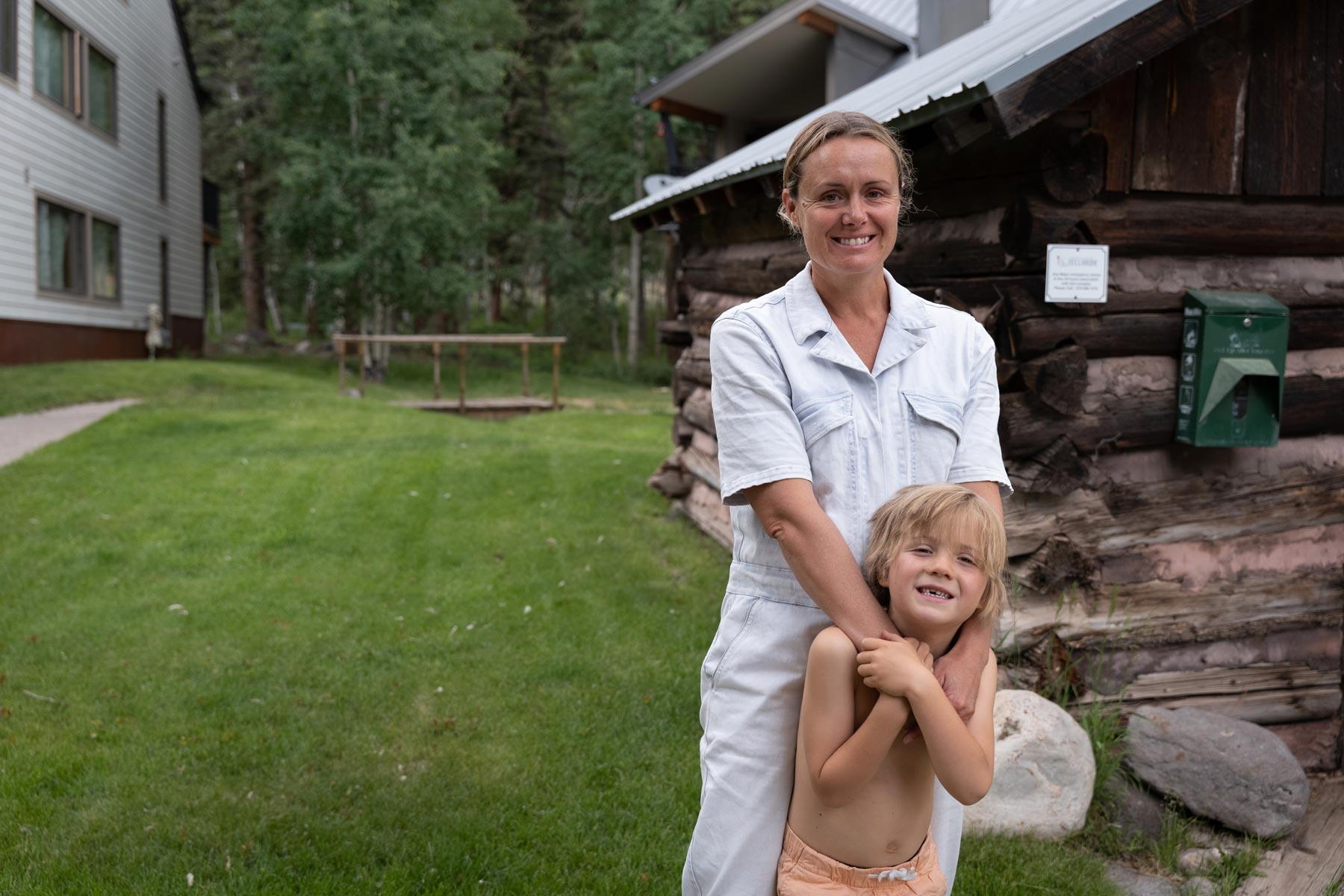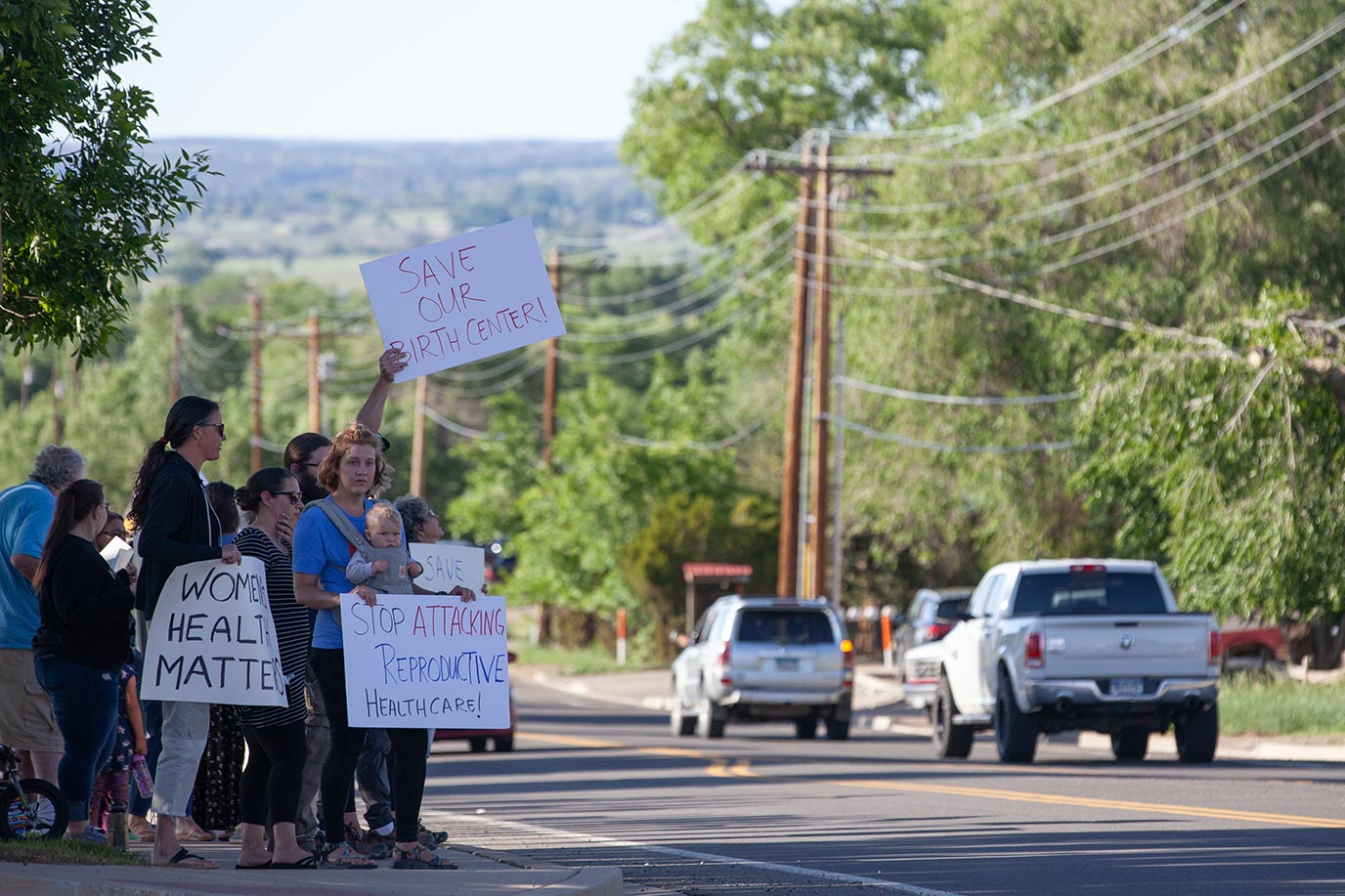When Georgina Bishop became pregnant with her third child, things got complicated. Not with the pregnancy itself or even the labor. But she did drive two-and-a-half hours—one way—to reach the hospital so she could give birth.
Bishop lives in Telluride. With her first two children—now 6 and 10 years old—she used a midwife in Montrose, about 65 miles north of the ski town. By the time she was pregnant with her third child, four years later, the midwife had closed up shop and retired.
Bishop was left with a decision: She could switch to the more traditional OB/GYN practice in Montrose or double her drive time for every appointment by using the next closest midwifery service, in Grand Junction.
“I loved the midwife experience and really wanted to stick with it,” Bishop says.
She had the benefit of running her own business (managing vacation rentals for owners), so she didn’t have to request time off for every ultrasound or checkup like she did with her first two children. She typically made those trips solo, as her husband couldn’t take off work at the same time or needed to stay back with the older kids.
The day after Bishop delivered their healthy third child, her husband headed back to Telluride, stayed with their two other kids, then drove them back to Grand Junction the following day so they could meet their new sister. All in, he traveled about 500 miles in three days.
It wasn’t until she first became pregnant though that Bishop understood how limited access to prenatal and delivery care was where she lives.
“You don’t really think about it until it’s you, and you realize how many appointments there are and most of the stuff’s not in Telluride,” she says. “I feel like the options have kind of dwindled over the years.”
Bishop’s situation isn’t uncommon in Colorado. Around 9% of births in the state take place in rural areas, and only 54% of the state’s rural counties have obstetric services. A 2020 report from March of Dimes identified two dozen maternity care deserts in Colorado, primarily in the east and south; these are defined as “any county without a hospital or birth center offering obstetric care and without any obstetric providers.”
Nationally, less than half of women residing in rural areas live within 30 minutes of a hospital with perinatal services. “In 2008, only 6.4% of obstetrician-gynecologists practiced in rural settings. By 2010, 49% of the 3,143 U.S. counties… lacked an obstetrician-gynecologist,” according to the American College of Obstetricians and Gynecologists.
Like Bishop, many rural residents take it in stride that they’ll have to travel for medical care, just like they do for the grocery store. But that doesn’t make it any easier.
“It’s kind of brutal, but I think everyone has this ‘let’s just get on with it’ mentality,” says Bishop. “It’s just what has to be done.”
***
By the mid-2010s, more than half of rural counties across the country were left with zero hospital-based obstetric care.
High costs and low patient volumes are primarily to blame. Providing labor and delivery care to a community is a pricey endeavor.
“The economies of scale are not on their side,” says Sara Leahy, director of member services for the Colorado Rural Health Center. “Most of our hospitals that are doing labor and delivery are doing it because it’s the right thing to do and their community wants it, and they have the workforce to provide it. But they’re not making revenue on it and are most certainly losing money.”
Further impacting hospitals’ bottom lines: Rural residents are more likely to rely on Medicaid, which reimburses providers at lower rates. In Colorado, Medicaid is the primary health care coverage for more than 40% of local births.
Administrators of rural hospitals in the U.S. estimate they need to facilitate at least 200 births annually for obstetric care to make financial sense and be safe for patients (physicians need to keep their skills current and have access to proper equipment). But rural populations are shrinking, making obstetrics departments less viable.
Colorado has 32 Critical Access Hospitals (CAHs)—facilities in designated rural areas more than 35 miles from the nearest hospital that have 25 or fewer inpatient beds. (This federal designation allows them to receive an additional 1% in Medicare reimbursements.) Only 18 of these venues have obstetric departments.
“It’s painful to see that a lot of labor and delivery departments at CAHs have closed over the last couple of decades,” Leahy says.
Primary care physicians and clinics have stepped in to fill some of the need for pre and postnatal care, but only a small percentage offer obstetric services.
Pregnancy is increasingly dangerous for Coloradans across the state. The state’s pregnancy-associated mortality rate almost doubled between 2008 and 2016, The Colorado Sun reported, though a July 2020 report by the state health department on maternal mortality in Colorado found no difference in death rates among urban and rural settings. (Other national research, including a 2019 study published in Health Affairs, has found that maternal and infant morbidity and mortality rates are generally higher among rural residents than urban).
Underlying health conditions are part of the problem, but so is low-quality prenatal care and limited health care access. A 2018 report in JAMA noted an increase in preterm births in rural counties without hospital-based obstetric care. And when the only hospital in town closes, research shows it results in a 4% reduction in per capita income and a 1.6% rise in the unemployment rate.
As with many health care disparities, women of color are disproportionately impacted. According to the Centers for Disease Control and Prevention, non-Hispanic Black and non-Hispanic American Indian/Alaska Native women are two to three times more likely to experience a pregnancy-related death than non-Hispanic white women.
“Whenever there are patients who are uninsured, who are on Medicaid, who are living in poverty,” Leahy says, “those are huge barriers to access no matter what, no matter if the prenatal care is the best of the best.”
***
Troy Wallace has lived in Nucla, a frontier community in southwest Colorado, for 22 years. From town, it’s nearly two hours to the closest hospital, Montrose Regional Health (MRH). He knows this not only because he’s the executive director of a local nonprofit resource provider, the West End Family Link Center, but because his daughter, Jorden Bonney, gave birth in an ambulance on the side of the road atop the Dallas Divide on her way to MRH.
There’s a local health care clinic about five miles south of town. And another in Norwood, 22 miles to the southeast. Both are open only during regular weekday business hours and can’t provide the level of care that labor and delivery requires.
“Years ago, we used to have a 24-hour [facility] with an emergency room and all that stuff when we were under the umbrella of Montrose Memorial Hospital [now MRH],” says Wallace. “They felt it was too costly to provide services over here with emergency services, so they took that away.”
After hours, residents rely on paramedics. Which is how Bonney found herself giving birth in the back of the ambulance.
The situation was unexpected, but the drive wasn’t. Women residing in the area have all their OB/GYN appointments in Montrose. Some even go to Grand Junction—an hour farther—to give birth.
“Our biggest challenge has been the workforce,” says Carmelo Hernandez, MD, a practicing OB/GYN and chief medical officer at San Luis Valley Health, which serves a population of around 50,000 people who face similar access challenges. Labor and delivery services are available at SLV Health’s Alamosa hospital; the next closest provider of such services is a 1.5-hour drive north, in Salida.
Hernandez is operating with fewer staff and a less experienced workforce that needs to be trained, which requires more time and effort from the senior team. In November 2021, SLV Health had just two obstetricians covering a department where around 40 babies are delivered every month. Recruitment has been further complicated by ongoing housing shortages and a lack of affordable housing throughout the state.
Patients feel the lack of access in their wallets, too. Wallace’s wife had a high-risk pregnancy, and her physician recommended she stay within a five-mile radius of the hospital for the final three months of her pregnancy. Luckily, Wallace’s sister lives in Grand Junction, so they didn’t have to shell out for a rental. But Bishop has friends who needed to stay in Grand Junction for weeks after their babies’ births because of complications. They had to pay for hotel rooms or Airbnb rentals.
“It just uproots your whole life,” Bishop says. “It’s financially stressful. A lot of people in Telluride… don’t have the legit health insurance that corporate jobs provide.”
Bishop relied on Medicaid with the birth of her first daughter, but she doled out north of $10,000 out-of-pocket for the delivery of her third child.
“Quite a few people here are living, barely, paycheck to paycheck,” Wallace says of his Nucla community. The West End Family Link Center sometimes provides them with gas money—that is, if they have cars. There is a nonprofit transportation service available, but that only works for pre-booked appointments, not babies who arrive whenever they feel like it.
“We take transportation for granted frequently, but often I hear around here that people don’t have the transportation. They’re relying on transportation services or taxis, which is another cost to individuals,” SLV Health’s Hernandez says.
“Think of the economy we’re living in these days with gasoline prices going up—that’s going to be a tremendous burden. And that’s in a routine pregnancy.”
The expanded use of telehealth (for perinatal care) and midwifery could help counter the myriad challenges pregnant women living in rural counties are facing. One OB/GYN with Banner Health launched a telehealth consultation pilot program in April to cut down on 100-mile commutes for patients and medical professionals.
This past legislative session, Colorado passed a $10 million grant program for rural health care providers. A series of bills—colloquially known as Colorado’s “Momnibus”—authorized in 2021 will also expand care options and bring more equity to maternal care, but they aren’t specifically aimed at rural populations or settings.
For women like Bishop and Bonney, that extra funding and support could ease some of the pressure during an already stressful period of life by upping the number of nearby providers and improving affordability. Bonney is currently pregnant with twins and is “displaced” until they arrive, her dad says: per her doctor’s orders, she’s living at Wallace’s brother’s house in Montrose so she can be closer to the hospital.




